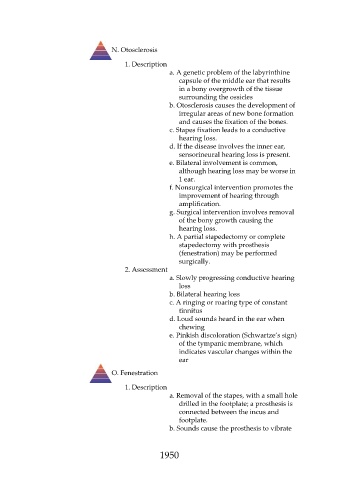Page 1950 - Saunders Comprehensive Review For NCLEX-RN
P. 1950
N. Otosclerosis
1. Description
a. A genetic problem of the labyrinthine
capsule of the middle ear that results
in a bony overgrowth of the tissue
surrounding the ossicles
b. Otosclerosis causes the development of
irregular areas of new bone formation
and causes the fixation of the bones.
c. Stapes fixation leads to a conductive
hearing loss.
d. If the disease involves the inner ear,
sensorineural hearing loss is present.
e. Bilateral involvement is common,
although hearing loss may be worse in
1 ear.
f. Nonsurgical intervention promotes the
improvement of hearing through
amplification.
g. Surgical intervention involves removal
of the bony growth causing the
hearing loss.
h. A partial stapedectomy or complete
stapedectomy with prosthesis
(fenestration) may be performed
surgically.
2. Assessment
a. Slowly progressing conductive hearing
loss
b. Bilateral hearing loss
c. A ringing or roaring type of constant
tinnitus
d. Loud sounds heard in the ear when
chewing
e. Pinkish discoloration (Schwartze’s sign)
of the tympanic membrane, which
indicates vascular changes within the
ear
O. Fenestration
1. Description
a. Removal of the stapes, with a small hole
drilled in the footplate; a prosthesis is
connected between the incus and
footplate.
b. Sounds cause the prosthesis to vibrate
1950

